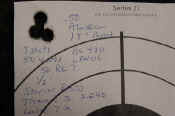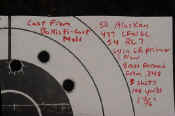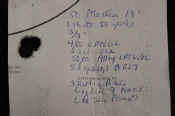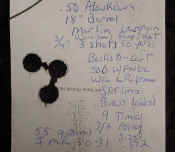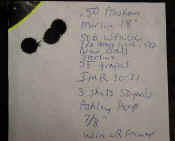![]()
THE .50 ALASKAN BUILT ON A MARLIN LEVERGUN
BY AL ANDERSON
The thought of having a .50 Alaskan levergun was on my mind more than once over the years, having read about Harold Johnson converting a Winchester 86 into one and also reading about Harry McGowen converting Winchesters 71 into the .50 Alaskan. The only problem was although I liked the 86 and 71, I liked them just the way they were in the good old Calibers they were chambered in. My Grandpa Otto had a 45-90 in an 86 and that may be what started me down the Levergun path over the years. I could never get myself to send off one of these rifles to be converted to .50 Alaskan.
It was sometime in the summer of '96 John Linebaugh and I were visiting when a guy I had never met before came over with a Marlin he was working on and going to chamber in the .500 Linebaugh or the 1.6Ē long version of the Linebaugh. His name was Regan Nonneman. This got me going as I like all Big Bore Sixguns and Leverguns! Even though it wasnít a .50 Alaskan I told him of my interest in one when he had it finished and left it at that.
In ' 99 John Linebaugh came for a visit. Out of the rig he pulled a dandy looking straight stocked, octagon barreled Marlin and it was chambered for the .50 Alaskan. I told him on the spot, "I want one!"
The rifle was built by Reg Nonneman of
Nonneman Custom Rifles of Maryville,
Missouri. John's rifle is stamped Number 1 and mine is Number 3. He knew what he
was doing bringing a big bore levergun for me to check out. John and I have been
friends for many years (since the mid- 80ís). He knows what I like in
firearms. I 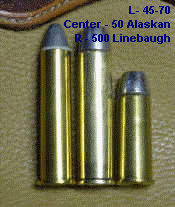 shoot his sixguns and five guns in .45 Colt, .475 Linebaugh and
.500 Linebaugh. I always enjoy when he comes for a visit because I know he is
going to pull some kind of a dandy sixgun out of the rig for me to shoot. Like
the time he finished building my .475 Linebaugh Ruger Bisley Vaquero 4 ĺĒ.
This was before Ruger had their Bisley Vaquero out. John made a stainless Bisley
grip frame for the Vaquero and put it on the Blued Vaquero. Dustin Linebaugh
made a set of custom grips that look like they grew out of the frame- he is
very talented. At any rate John and Dustin drove all night to deliver it to me! How's
that for service?
shoot his sixguns and five guns in .45 Colt, .475 Linebaugh and
.500 Linebaugh. I always enjoy when he comes for a visit because I know he is
going to pull some kind of a dandy sixgun out of the rig for me to shoot. Like
the time he finished building my .475 Linebaugh Ruger Bisley Vaquero 4 ĺĒ.
This was before Ruger had their Bisley Vaquero out. John made a stainless Bisley
grip frame for the Vaquero and put it on the Blued Vaquero. Dustin Linebaugh
made a set of custom grips that look like they grew out of the frame- he is
very talented. At any rate John and Dustin drove all night to deliver it to me! How's
that for service?
Dustin has the same .475 as mine, and it can be seen in the May/June 1997 issue of American Handgunner in an article by John Taffin. It was in September of '96 when they had all of the sixguns in the article over to the house for me to shoot.
Back to the .50 Alaskan. I told John, " Iíve got to shoot that thing! Iíll round up a couple of Horses and saddle 'em up and weíll head out Aíhorseback and shoot some rocks, stumps and trees to test it out."
I admit John had a funny look on his face when I slid the freshly blued Alaskan into the scabbard, but he got over it as thatís what they were meant to be used for - a working gun. The only bullets we had were some 410 grain LBT LFN plain base bullets I was shooting out of my .500 Linebaugh. After shooting them into some stumps and trees at 600 fps or more than out out the sixgun we found out they werenít penetrating all that good. We knew at the higher velocities we would need a longer heavier bullet of a good alloy and or heat treated to realize the full potential of the Alaskanís ability to penetrate on big game. I called Ballisti-Cast of North Dakota, makers of fine bullet molds and they told me they had a 500 grain WFN GC mold that would work in the .50 Alaskan. Even though I am not the biggest fan of WFN shaped bullets I told them I would take one. I talked to them about making a mold with an LFN shaped nose and that they did a little later. It weighs around 480 or so with the 17 grain gas check attached. And for the non-caster Cast Performance ( www.castperformance.com ) in Wyoming makes good quality heat treated cast bullets for the .50 Alaskan.
Well, after calling Reg and talking to him about building my Alaskan I assumed he would need me to send him a Marlin 95 in .45-70 or .444 to build on, but that wasnít the case. Reg said he can build them on the Marlin 336 action. That sounded good to me. Although I like .30-30 Leverguns I didnít feel as bad having to send him a 30-30 to build on rather than a .444 or .45-70. They are just too good to part with.
I ordered the .50 with a 20Ē
octagon barrel with the thinking: it is a rifle for use on big dangerous game in
heavy brush when a guy canít have a big sixgun with him. Since then Iíve
had the .50 rebarreled to an 18Ē octagon that tapers to a very thin muzzle
with just enough meat to cut the dovetail for the front sight. Now it is really
a handy little rifle for use in thick brush and the next best thing to a sixgun.
I have always liked to carry and shoot the Trapper sized leverguns when there
just isnít room to be swinging a 22Ē-26Ē barreled rifle, but I do like to
shoot the longer barreled leverguns when in open country. The short ones carry well in a small scabbard when ahorse back
or when afoot in heavy timber. I
once had to stop a charging bear and it sure feels good to have a rifle that you
can get into action fast, since a bear with a bad attitude can really cover the
ground quickly.
![]()
I also had Reg convert the pistol grip to a straight grip as thatís my favorite type of Levergun. About the only pistol griped levergun I have that I can say I really like is my Winchester 71 Deluxe in .348. It looks and feels good to me. I thought a custom rifle should have a custom stock so I had my good friend Dennis Peterson make me the stock for it. He also does a fine job on bolt action and single shot rifle stocks, with very good checkering.
We went with a semi-fancy walnut because we didnít know how well it would hold up to the recoil dished out from the big .50. I like a rather thin forearm on a levergun but Dennis left it a little thicker than normal to go over the big magazine tube. The tube is full length and holds 6 cartridges. He also used a special insert in the tang that Reg made for it. The stock was left a little fuller than normal but I figure with a lot of tough use the next time he refinishes it for me he can thin it up a little and recut the checkering. I also had him install a Pachmayer Decelerator Recoil Pad on the custom stock and it sure does the job. You canít shoot 450-500 grain bullets at anywhere from 1600-2000 fps and not expect to feel them a little bit. A little recoilís not to bad once in a while to wake you up and blow the cob webs out.
Speaking of recoil - if you're used to shooting a .45-70 with top loads you wonít have any trouble with the .50 Alaskan. My Alaskan weighs 7 pounds with 18Ē barrel, John's is 7 Ĺ with the 20Ē. As a comparison my Marlin Guide guns weigh around 7 pounds. The Winchester 94 Trappers with 16Ē barrels weigh around 6 pounds, so the .50 is a lot of horse power in a small package.
As for the sights I went with a Ashley Ghost ring, and Reg made up a good flat blade for the front. The Ashley is a good strong sight and fast to pick up whatever you happen to be shooting at. The only thing I have noticed that I canít shoot as small of groups with the Ashley as I can with my Williams Peepís with smaller hole. Reg said that he is going to tap out the Ashley so a Williams can be screwed into the Ashley when testing loads, and then just screw it out when hunting in poor light. I found sometimes depending on light that my groups would be half the size when using the Williams.
Next came getting brass ready to be loaded. The .50 Alaskan is formed from .348 Winchester brass. It is a little bit of a project but works well if you use a tool in the reloading press to step it from .348 to .50 Caliber. You can also use different expanders from other die sets and gradually step it up itís a little slower but it does work.
Then itís only a matter of loading a bullet and powder and shooting them to fire form them. They come out looking good. I trim them to length on my RCBS Trim Pro Electric Trimmer with a .50 cal cutter and .50 cal pilot. It doesnít take long to get them all to the proper length with this trimmer and it is also very accurate. The .50 Alaskanís length is 2.1 but to get them all to the same length so as to get a more uniform crimp I trim all my brass back to 2.090 and they work fine.
Shooting a .50 Alaskan
just got a lot easier as Starline is now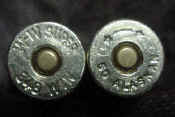 making properly formed and head stamped brass for it. If you have used
Starline brass for your sixguns I donít have to tell you how good it is. I
believe they have some of the most uniform flash holes on their brass also. The
first handful of brass I had to test is still going strong after many loadings.
making properly formed and head stamped brass for it. If you have used
Starline brass for your sixguns I donít have to tell you how good it is. I
believe they have some of the most uniform flash holes on their brass also. The
first handful of brass I had to test is still going strong after many loadings.
I found that J&J products makes a 20 round ammo box that holds the .50 very well. It is marked .45-70-600NE.
For the bullets I cast from Ballisti-cast molds that require a gas check. I get them from Bullet Swaging Supply in West Monroe, LA. Even though I like bullets that are either of the LFN or Keith shape, the big 505 WFN GC shoots very well in the Alaskan. I donít know how he does it but when Regan Nonneman gets done with the rifle it loads the LFN, Keith and WFN bullets through the Loading Gate no problem at all. And most importantly, they all feed very well also.
The big thing with lever guns is hold them tight to your shoulder and really work the lever and youíll have no problem at all. They were not made to be laying on their side and worked slowly. Its good to learn to work them hard and fast just in case the day comes when something is looking to take a bite out of you. Then it will come naturally. I think its good to pop a few caps every day and its also a lot of fun.
I picked up my Dies for reloading the .50 from RCBS and they work fine. I understand that C&H is also making them. I prime the cases with a Hornady Hand priming tool. It takes the same shell holder as the reloading press and works very well. The case is too big to use the Lee hand priming tool. I ground out a Lee to work for the .500 Linebaugh when I first started loading them but now I load them on a Dillon 550 press.
After testing and shooting a lot of different bullets and powders in the .50 here are some of the bullets I have shot:
-
410 LBT LFN PB
-
425 NEI Keith PB
-
480 LFN GC from the Ballisti-cast mold
-
505 WFN GC from the Ballisti-cast mold
That is the weight they weigh cast from a 50/50 mix of Linotype and Wheelweight. They are all sized .512 ď.
 Left
to Right: 405 gr. RCBS .458" / LBT 410 gr. LFN .512" / Keith-type 425
gr. .512" / Ballisticast 430 gr. LFN .512" / Ballisticast 480 gr.
LFNGC .512" / Ballisticast 505 gr. WFNGC .512"
Left
to Right: 405 gr. RCBS .458" / LBT 410 gr. LFN .512" / Keith-type 425
gr. .512" / Ballisticast 430 gr. LFN .512" / Ballisticast 480 gr.
LFNGC .512" / Ballisticast 505 gr. WFNGC .512"
Iíve also shot the 450 Barnes JacketedFlat nose that is sized .510 as well as the Alaska Bullet Works 450 gr. JFN.
There are new bullets coming along that will hold up to what this rifle can dish out with out falling apart, so that its full potential will be realized when shooting the very largest of game.
Here are a few of the loads that I like to shoot. I kept track of how they penetrated in wet gun list and oak boards, The cow bones were buried in the snow so I slipped in two inches of oak boards to act as bone after two inches of wet print. I think just shooting into wet print doesnít tell the whole story as Iíve never shot any big game animal yet that didnít have some kind of bone to shoot through. It seems like to me if I pull the boards out and just shoot through the paper you get another third or so of total penetration, so the boards or bones do slow down the bullets. There's no doubt about that.
The OAL with the 410, 430 and 480 LFNís is 2.475. The OAL with the 505 WFN is 2.500 and the Alaska Bullet works 450 is 2.470 while the Barnes 450 is 2.410 and all bullets feed well at those lengths.
410 LFN PB loaded over 50 grains of A RL7 is a fun light load to shoot with velocity in the 1500 range or so but still has a lot of power. This load shoots around 1 ĹĒ at 50 yards.430 LFN PB loaded over 50 grains of A RL 7 is a little step up and it shoots in the 1 3/8Ērange at 50 yards and 3 3/8Ē range at 100yards. Velocity is 1600. This load penetrated 22Ē recovered weight was 420.6 and expanded to .600.
480 LFN GC loaded over 54 grains of A RL 7 is one of my favorite loads and will shoot from ĹĒ-1 ĺĒ at 50 yards depending on light and will shoot anywhere from 2Ē-almost 4Ē at 100 yards. Velocity from 18Ē barrel is 1730. This load penetrated 32Ē recovered weight was 469.7 with gas check still on and expanded to .540. With softer alloy it will expand to .725 and weight will be in the 450 range and also expect it to penetrate 6Ē-10 less than the harder alloy.
505 WFN GC loaded over 55 grains of IMR 30-31 is a load this rifle really likes it will shoot under 1Ē at 50 yards and under 2Ē at 100 yards if I do my part. Velocity with this load is only around 1500 FPS but it will do a lot of work at that speed. This load penetrated 29Ē and expanded to .580 and recovered weight was 495.2.
Just to show you how higher velocity and a Jacketed bullet with soft lead core does is this same test medium. I loaded the 450 grain jacketed bullet over 57 grains of A RL 7 It shoots just over 2Ē at 50 yards and velocity is 1860. Penetration was 13Ē and bullet expanded to .865 and recovered weight was 359.2 grains.
I didnít do this to make this bullet look bad, I only did it to show you that if you want penetration on big heavy-boned game, if you get the velocity too high the bullet wonít hold up and penetration is going to suffer. Of course if you use a solid that will hold up more velocity will mean more penetration. On thin skinned dangerous game this 450 JFN bullet would have made quite a hole and caused a lot of damage but on big bones and heavy hide it would have had trouble getting in. Choose your bullets wisely as to the type of game you are going to be hunting. Donít be afraid to shoot them into some kind of test medium to see what they will do. Granted its not like the real thing but it does show a trend as to how it will act on game.
Just to show you how tough this test medium was, here are a couple of tests with other firearms that most guys are familiar with:
Lyman 250 Keith cast out of #2 alloy over 20 grains of A 2400 and shot out of a .44 Ruger Bisley 5 ĹĒ only penetrated 10Ē-12Ē. That load has gone almost double that with a harder bullet and a little more velocity in just wet print with no bones or wood.
The .475 Linebaugh and 400 grain Gold Dot SP loaded over 26 grains W296 with velocity of 1228 only went 3Ē and expanded to .765 recovered weight was 382.7 and it stayed together.
A 400 grain Keith cast from a RCBS mold and loaded over 28 grains of H110 in the .475 Linebaugh with a velocity of 1300 penetrated 22Ē and expanded to .600 and recovered weight was 392.4.
The .500 Linebaugh loaded with a 428 grain Keith from NEI mold and cast of Linotype loaded over 30 grains of H110 with a velocity of 1251 went 21 inches and never expanded and still weighed 420 grains.
Other guys Iíve talked to are having good luck with using H Benchmark to obtain high velocity. They are also using bullets of a heavy jacketed construction but until I try them I wonít know for sure how they work for me. Iíve also had good luck with IMR and H 4198. Velocity and accuracy have both been good. With either powder and either the 480 LFN or the 505 WFN accuracy is in the 2-4Ē range at 100 yards and velocity is in the 1700-1800 range. Like any rifle you should try different primers to see what's best in your rifle, as it does make a difference.
The only game animal Iíve shot with the .50 Alaskan was
a large Red Stag Bull and it was the size of a small Elk. He was standing in 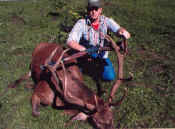 a
patch of heavy timber and with the tree cover it was dark and hard to see him
all that well. When I could get a good sight picture and I thought he was
standing broadside I let him have it with one of the 480 grain LFNís loaded
over 54 grains of RL7. At the shot he went down and then got up and turned so I
hit him again, this time on his left side and he went down for good. Later I
realized he was standing at more of an angle and the first shot went in just
behind his right shoulder and came out on his left flank. The second shot went
in just behind his left ribs and stopped under the skin on the point of his
right shoulder. You can see that in the photo. On an
a
patch of heavy timber and with the tree cover it was dark and hard to see him
all that well. When I could get a good sight picture and I thought he was
standing broadside I let him have it with one of the 480 grain LFNís loaded
over 54 grains of RL7. At the shot he went down and then got up and turned so I
hit him again, this time on his left side and he went down for good. Later I
realized he was standing at more of an angle and the first shot went in just
behind his right shoulder and came out on his left flank. The second shot went
in just behind his left ribs and stopped under the skin on the point of his
right shoulder. You can see that in the photo. On an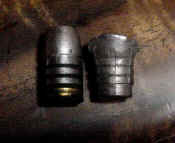 animal that size it was 2
Ĺ to 3 feet of penetration. The recovered bullet weighed 433.6 grains and was
expanded to .685. Next winter I am going to shoot another Buffalo. Iím
leaving the Sharps home this time and Iím going to use the .50 Alaskan on it
so Iíll let you know how that one turns out.
animal that size it was 2
Ĺ to 3 feet of penetration. The recovered bullet weighed 433.6 grains and was
expanded to .685. Next winter I am going to shoot another Buffalo. Iím
leaving the Sharps home this time and Iím going to use the .50 Alaskan on it
so Iíll let you know how that one turns out.
I havenít tried to leave anyone out of this as far as rifle builders go but wrote about Regan Nonnemanís rifle he built for me and how it performed. I donít know if Harry McGowen is still building them or not. Another rifle builder Iíve heard of but have not talked to is Wild West guns. I believe they are in Alaska. There may be more out there so if you want one built I donít think you should have any problem finding someone to build you one. As a matter of fact there has probably never been a better time to get one and with the available brass, dies, bullets and molds out there itís a perfect time to give one a try.
If you're like me and like big bore leverguns and sixguns the .50 Alaskan might be just what you need. I like to have a carbine of some sort for every caliber sixgun that I shoot. If you shoot a .500 Linebaugh or .500 Long you could also shoot them in the rifle. So if you are able to have one made I hope you have as much fun with it as Iím having with mine. Everyone that sees it sure seems to like it such power in a small package.
Thatís the .50 Alaskan on a Marlin Levergun!
The following pressure data was provided by Hodgdon powder for the .50 Alaskan and I obtained it from Regan Nonneman.
|
.50
Alaskan Data |
|||||||
|
Bullet: 435 gr. LFN GC .510" diam. C.O.L. 2.460" |
|||||||
|
Starting Loads |
|
Maximum Loads |
|||||
|
Powder |
Grains |
Velocity |
Pressure |
Grains |
Velocity |
Pressure |
|
|
H322 |
62.0 |
1856 |
25,500 CUP |
66/0 |
1994 |
33,800 CUP |
|
|
H4198 |
52.0 |
1912 |
26.100 CUP |
62/0 |
2089 |
35.500 CUP |
|
|
|
|||||||
|
Bullet: 450 gr. BAR FP ,510" dia. C.O.L. 2,420" |
|||||||
|
Benchmark |
59/0 |
1718 |
25,400 CUP |
|
63.0 |
1878 |
35,100 CUP |
|
H322 |
57.0 |
1732 |
26,200 CUP |
60.5 |
1876 |
34,600 CUP |
|
|
H4198 |
52.0 |
1772 |
24,700 CUP |
56.0 |
194- |
35,300 CUP |
|
|
|
|||||||
|
Bullet: 500 gr. JFP .510" diam. C.O.L. 2.500" |
|||||||
|
H322 |
56.0 |
1674 |
25,900 CUP |
|
59.5 |
1819 |
33,900CUP |
|
H4198 |
51.0 |
1719 |
28,600 CUP |
55.0 |
1854 |
34,500 CUP |
|
|
|
|||||||
|
Bullet: 525 gr. LFN GC .510" dia. C.O.L. 2.520" |
|||||||
|
Benchmark |
59.0 |
1694 |
25,800 CUP |
|
63.0 |
1820 |
34,300 CUP |
|
H322 |
56/0 |
1691 |
27,100 CUP |
60.0 |
1825 |
34,200 CUP |
|
|
H4198 |
51.0 |
1724 |
27,300 CUP |
55.0 |
1852 |
34,800 CUP |
|
Pressure Testing was done by Hodgdon Powder Co., Inc. www.hodgdon.com
